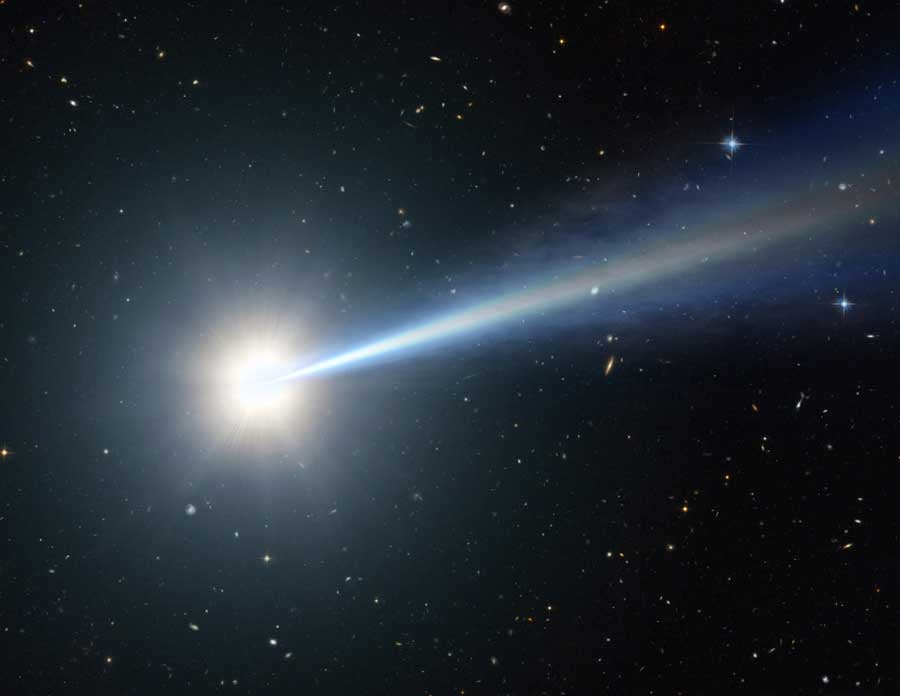Key takeaways:
- Astronomers have found the largest and farthest water reservoir in the universe, 140 trillion times the amount of water in Earth’s oceans, surrounding a quasar 12 billion light-years away.
- This water vapor, unlike the frozen water in the Milky Way, exists in a massive gaseous region, heated by the quasar’s X-rays and infrared radiation, making it warmer and denser than typical galactic gas.
- The quasar, APM 08279+5255, hosts a black hole 20 billion times more massive than the Sun and produces energy equivalent to a thousand trillion Suns.
- Observations indicate that the gas around the black hole could help it grow up to six times larger, though some of the gas may condense into stars or be ejected from the quasar.
- Two independent teams discovered this water using advanced telescopes like Z-Spec in Hawaii and the Plateau de Bure Interferometer in the French Alps, with each team contributing key findings about the water’s mass and composition.
___________________
Astronomers discover largest water reservoir surrounding a quasar 12 billion light-years away.
Astronomers have detected the largest and most distant reservoir of water ever found in the universe, surrounding a quasar more than 12 billion light-years away. This discovery reveals a massive cloud of water vapor, 140 trillion times the amount in Earth’s oceans, located near a supermassive black hole known as APM 08279+5255.
This quasar, powered by a black hole 20 billion times the mass of the Sun, produces as much energy as a thousand trillion suns. As the black hole consumes surrounding gas and dust, it releases tremendous energy, creating an environment rich with water vapor. Matt Bradford from NASA’s Jet Propulsion Laboratory in Pasadena, California, notes, “This discovery demonstrates that water is pervasive throughout the universe, even in its early stages.”
Water in the Early Universe
The quasar’s water vapor exists in a gaseous region stretching hundreds of light-years around the black hole. Despite its vast distance and age, this quasar shows that water vapor was present even in the early universe. Though water vapor exists in the Milky Way, it’s 4,000 times less than what was found near the quasar, as most of our galaxy’s water is frozen in ice.

Water vapor is an essential trace gas that helps astronomers understand the nature of distant objects. In this case, the vapor’s presence indicates that the quasar is bathing the gas in X-rays and infrared radiation, making it unusually warm and dense compared to typical galactic environments. The gas surrounding the quasar is still extremely cold at –63° Fahrenheit (–53° Celsius), but it’s five times hotter and much denser than similar regions in the Milky Way.
Measuring the Quasar’s Future
By measuring water vapor and other molecules, like carbon monoxide, scientists estimate that there is enough gas to allow the quasar’s black hole to grow to six times its current size. However, it’s uncertain if all the gas will be consumed by the black hole, as some may condense into stars or be expelled from the quasar.
The discovery was made through observations by two teams. One team, led by Bradford, used the Z-Spec instrument at the California Institute of Technology’s Submillimeter Observatory in Hawaii starting in 2008. Follow-up observations were conducted with the Combined Array for Research in Millimeter-Wave Astronomy (CARMA) in Southern California. A second team, led by Dariusz Lis from Caltech, used the Plateau de Bure Interferometer in the French Alps to detect water in 2010. While Lis’s team found one spectral signature of water, Bradford’s group captured several, allowing them to determine the vast size of the water reservoir.
This discovery highlights not only the abundance of water in the universe but also the complexity and richness of quasars in shaping cosmic environments, even in the early universe.
